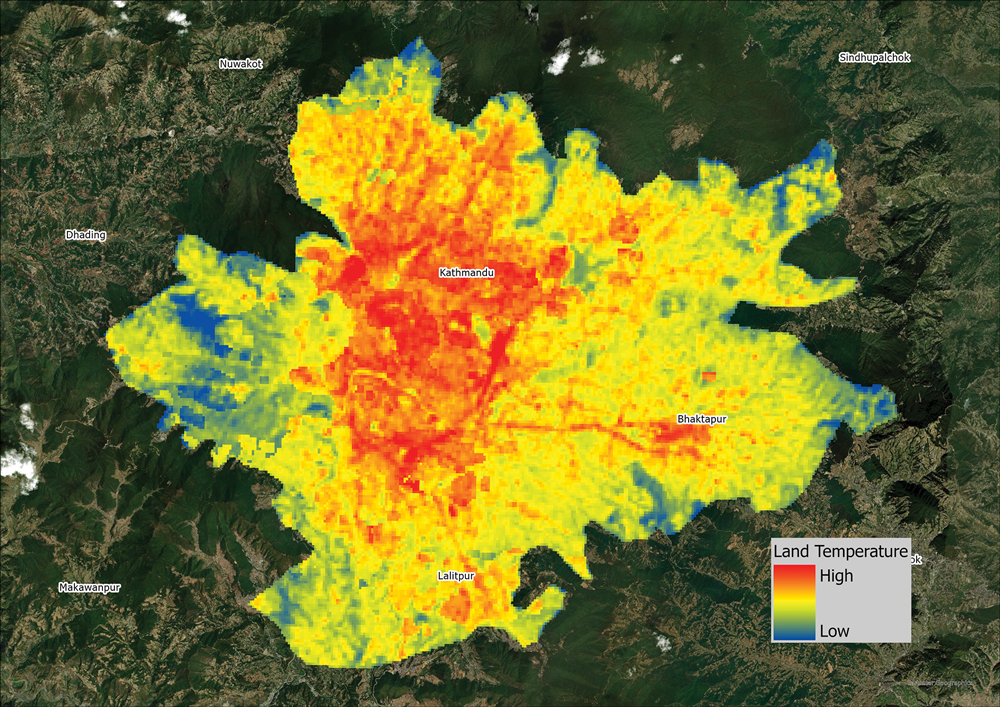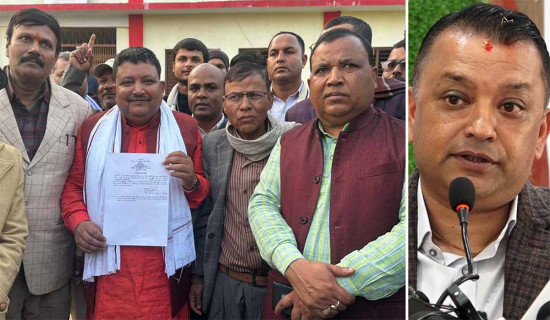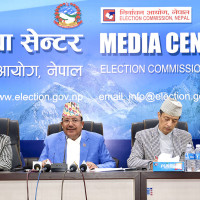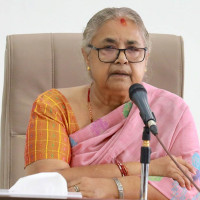- Wednesday, 21 January 2026
Surge in urban temperature calls for enhanced green initiatives
Kathmandu, June 9: As the sun rises over the Kathmandu Valley, Sita Lama begins her daily walk to work. The once-cool mornings have turned oppressively hot; she suspects the effect of the increasing population and felling of big trees in the Valley.
The journey through the busy streets of Kathmandu, where temperatures can be up to 5 degrees Celsius higher than the surrounding districts, reveals a city grappling with the Urban Heat Island (UHI) effect.
Lama remembers her childhood, playing under the shade of large trees in the Bouddha area. The air was cooler, and fresher. Now, in the heart of Kathmandu, those green reserves are few and far between. Concrete and blacktop rule the roads, absorbing and radiating heat, making the city almost like an oven.
The rapid population growth and unplanned urbanization in Kathmandu have led to worsening air pollution and UHI effects. In 2000, the population of the Kathmandu Valley was around 1.6 million. By 2021, this number had grown significantly to around 3.1 million, reflecting substantial urban expansion and population growth over the 23 years, according to the latest census.
Population growth and urbanization in Kathmandu have led to significant environmental changes, including a marked surface UHI effect, impacting livability and urban climate.
A study by Darshana Athukorala of the National Institute for Environmental Studies, Japan, using Landsat images from 2000, 2013, and 2020 found that urban expansion increased mean land surface temperatures, especially in the city core.
The research published in ResearchGate said that green spaces were denser on the periphery, leading to lower UHI effects outside the city centre. The findings highlight the need for sustainable urban planning and green space enhancement to mitigate UHI effects in Kathmandu.
Another study also highlights the stark temperature differences between vegetated and non-vegetated areas. The study also shows that areas with dense vegetation can be from 2 to 5 degrees Celsius cooler than the urban heat traps of the city.
Uttam Babu Shrestha, an environmental scholar and researcher, said that while studying UHI in various places of Kathmandu last year, they found that open spaces have temperatures 3 to 4 degrees Celsius higher than areas with tree plantations.
The preliminary results comparing the Tribhuvan International Airport and below jungle area, Jawalakhel Central Zoo area with Kumaripati area, and inner New Road area with Khula Manch show temperature differences of 3 to 4 degrees Celsius, Shrestha said.
“We have used the Thermal Band’s Landsat Satellite to receive the data and found that there is cooler temperature in shaded areas, highlighting the importance of planting trees in open spaces,” he added.
He further added that these are only preliminary findings and the research is yet to be published. The research shows that there is a need to develop green belts in urban areas.
Current facts
According to NASA, the global average temperature has risen by about 1.1 degrees Celsius since the late 19th century. The decade from 2010 to 2019 was the hottest on record.
The World Meteorological Organisation (WMO) reported that 2023 saw unprecedented heatwaves across Europe, North America, and Asia, with temperatures reaching record highs.
Similarly, the Intergovernmental Panel on Climate Change (IPCC) 2021 report indicated that global sea levels have risen by about 20 centimetres since 1900, with the rate of rise accelerating in recent decades due to thermal expansion and melting ice.
Recent studies by the International Centre for Integrated Mountain Development (ICIMOD) reveal alarming glacier melt rates in Nepal's Himalayan region. The data indicates that glaciers have been retreating faster over the past few decades, with an estimated 1.5 per cent loss in glacier area annually.
This rapid melting is primarily driven by rising temperatures and changing precipitation patterns due to climate change. ICIMOD's latest research shows that the Imja, Khumbu, and Langtang glaciers have experienced significant ice loss, leading to the formation of large glacial lakes and increased risks of glacial lake outburst floods (GLOFs).
Within this context, World Environment Day was marked on Wednesday with the theme “Our land. Our future. We are #GenerationRestoration,” which emphasised the urgent need for land restoration to combat desertification and improve drought resilience.
The theme is linked to the efforts to restore and expand green spaces in urban and rural areas that can help lower temperatures and improve resilience against climate extremes, experts said. Reforestation and the creation of urban green spaces can absorb more carbon dioxide, reducing greenhouse gas concentrations and cooling local microclimates, they said.
Deepak Gyawali, Spokesperson at the Department of Environment, said that the presence of trees and green spaces provides natural cooling through processes like shade provision and evapotranspiration. "It is important to plant trees, but there should be a study on which types of plants are needed for each urban, and semi-urban area,” he added.
Health impacts
Dr. Megh Nath Dhimal of the Nepal Health Research Council (NHRC) conducted research in 2018 including everyday data from 30 years (1987 to 2016) from 40 meteorological stations throughout the country revealing that heat waves have become more frequent and intense in Nepal over recent years, a trend that is largely attributed to climate change.
Dr. Dhimal said that the research highlights the increasing temperatures, particularly in the Tarai region, where the mercury has soared above 40 degrees Celsius, severely affecting the health and livelihoods of the population.
“We have also observed a rise in cases of heat-related illnesses, including dehydration, heat strokes, and other heat-induced conditions. Vulnerable populations such as the elderly, children, and those with pre-existing health conditions are at higher risk,” he said.
He said that urban areas, with their high concentration of heat emissions and heat-absorbing infrastructure, can be up to 10 degrees Celsius warmer than surrounding regions due to occupational heat exposure, particularly in low-income countries like Nepal.
To build resilience, it is crucial to invest in water and sanitation, nutritious food access, electricity, and public health services. Adaptation strategies include climate-sensitive architectural design, cooling systems powered by renewable energy, and improved assessment methods using meteorological data, he added.
What DHM data says
According to Sudarshan Humagain, a meteorologist at the Department of Hydrology and Meteorology, climate variability has been observed in the Kathmandu Valley. “We cannot confirm that we are experiencing the effects of climate change, but based on DHM data, we can say that we have been witnessing climate variability over the past three decades,” he added.
Heatwaves were witnessed in 1990, 1999, 2010, 2013, 2019, and 2023 in Kathmandu. The duration of the heatwave in 1999 was 17 days, 14 days in 2010, and 13 days in 2023, indicating climate variability in Kathmandu.
The highest temperature ever recorded in Nepal was in Dipayal at 46.6 degrees Celsius on June 16, 1995. Nawalparasi also recorded a high temperature of 45.2 degrees Celsius on June 3, 1995, Humagain added.
In Kathmandu, the highest temperature was recorded in 1994 at 35.2 degrees Celsius. Following that, the second highest was recorded in 1995 at 34.4 degrees Celsius, then 34.1 in 2005, and finally 34.4 in May 2024. The temperature in Bhaktapur was slightly higher, reaching 35.5 degrees Celsius, according to the Department of Hydrology and Meteorology.
According to Humagain, in 2010, the northern hemisphere experienced one of its most severe heatwaves, which had significant repercussions on the climate and weather patterns in many parts of the world, including Asia. A strong LaNina event (a global climate phenomenon that emerges from variations in winds and sea surface temperatures over the tropical Pacific Ocean) in June 2010 contributed to unusual and prolonged heatwaves in several Asian countries, including China, Japan, and South Korea, he added.
Average maximum temperatures recorded in Bhaktapur, Khumaltar, and Kathmandu Airport from 1967 to 2024 show fluctuating patterns. Bhaktapur generally maintains higher temperatures compared to Khumaltar and Kathmandu Airport, with peaks observed in 1989 and 2024.
Outlook
Hotspots within Kathmandu experience the highest temperatures due to factors such as dense construction, lack of green spaces, and high vehicular emissions.
So urban greening strategies like green roofs and urban forestry, along with the use of reflective building materials, are effective in reducing urban heat, experts said. These areas, such as forests, parks, and other green spaces, tend to be cooler. The temperature in these areas is generally lower due to the shading and cooling effects of trees and vegetation.
















